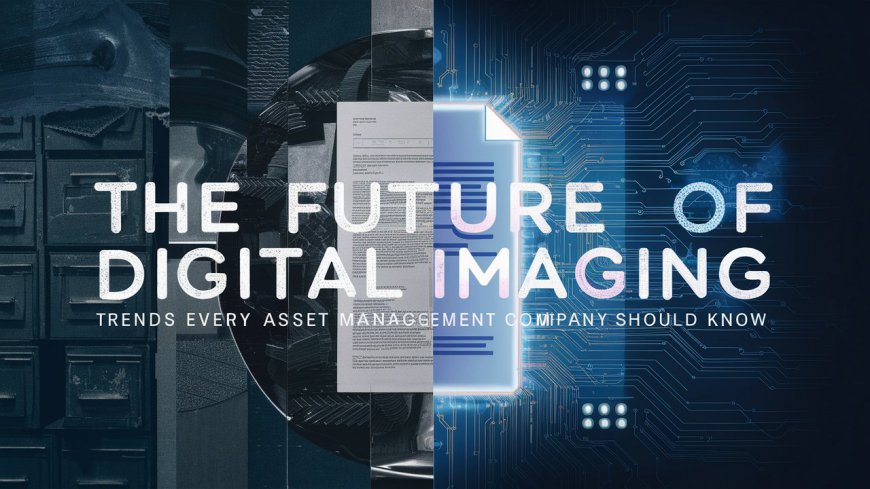The Future of Digital Imaging: Trends Every Asset Management Company Should Know
Explore future trends in digital imaging and their impact on asset management companies. Learn about AI, blockchain, cloud solutions, and more for enhanced efficiency.

In the rapidly evolving landscape of technology, digital imaging stands out as a crucial area of development, particularly for asset management companies. As the world moves toward a more digital-centric approach, understanding the future of digital imaging and its implications on document imaging, digital documents, and document imaging solutions is essential. This article delves into the key trends shaping the future of digital imaging, providing valuable insights for asset management companies aiming to stay ahead of the curve.
The Rise of AI and Machine Learning in Digital Imaging
Artificial Intelligence (AI) and Machine Learning (ML) are revolutionizing digital imaging. These technologies are enabling more sophisticated and accurate image recognition, classification, and analysis. For asset management companies, AI-powered document imaging solutions can significantly enhance the efficiency and accuracy of processing digital documents. AI algorithms can automatically categorize documents, extract relevant data, and even detect anomalies, thus reducing the time and effort required for manual processing.
Enhanced Image Resolution and Quality
Advancements in digital imaging technology are continually improving the resolution and quality of images. High-resolution imaging is becoming more accessible, allowing asset management companies to maintain clearer and more detailed digital records. This is particularly important for document imaging, where the clarity of text and details in documents can affect the accuracy of data extraction and interpretation.
Integration of Blockchain Technology
Blockchain technology is emerging as a game-changer in the realm of digital imaging. Its application in digital documents ensures immutability, transparency, and security. For asset management companies, integrating blockchain with document imaging solutions can enhance data integrity and provide a verifiable audit trail. This can be particularly beneficial in maintaining compliance and ensuring the authenticity of critical documents.
Cloud-Based Document Imaging Solutions
The shift to cloud-based solutions is another significant trend in digital imaging. Cloud storage offers scalable, secure, and accessible options for storing and managing digital documents. For asset management companies, adopting cloud-based document imaging solutions can provide seamless access to documents from anywhere, facilitate collaboration, and reduce the need for physical storage space. Moreover, cloud solutions often come with advanced security features, ensuring that sensitive information is well-protected.
Mobile Imaging Technology
With the proliferation of smartphones and tablets, mobile imaging technology is becoming increasingly important. Mobile document imaging solutions allow asset management professionals to capture, process, and manage documents on the go. This flexibility can lead to improved productivity and efficiency, as documents can be quickly digitized and integrated into the company's digital workflow from virtually any location.
Automation and Workflow Integration
Automation is at the forefront of the future of digital imaging. Automated document imaging solutions streamline the workflow by integrating seamlessly with other business processes. For asset management companies, this means faster processing times, reduced human error, and more efficient management of digital documents. Automation tools can handle repetitive tasks such as document sorting, indexing, and data entry, freeing up employees to focus on more strategic activities.
Enhanced Security Measures
As digital imaging becomes more prevalent, the need for robust security measures becomes paramount. Advanced encryption techniques, secure access controls, and regular security audits are essential components of modern document imaging solutions. For asset management companies, investing in secure digital imaging technology can protect sensitive financial data and ensure compliance with industry regulations.
The Role of Big Data Analytics
Big Data analytics is transforming how asset management companies handle digital documents. By analyzing large volumes of imaging data, companies can gain valuable insights into operational efficiency, client behavior, and market trends. Document imaging solutions equipped with Big Data capabilities can provide actionable intelligence that supports decision-making and strategic planning.
Sustainability and Digital Imaging
Sustainability is becoming an increasingly important consideration for businesses. Digital imaging contributes to environmental sustainability by reducing the need for paper documents and physical storage. For asset management companies, adopting digital documents and document imaging solutions not only supports eco-friendly practices but also reduces costs associated with printing, storing, and managing physical documents.
Conclusion
The future of digital imaging holds immense potential for asset management companies. By staying abreast of the latest trends in AI and ML, enhanced image resolution, blockchain integration, cloud-based solutions, mobile imaging, automation, security, Big Data analytics, and sustainability, companies can optimize their operations and remain competitive in a digital-first world. Embracing these advancements in digital imaging and document imaging solutions will not only improve efficiency and accuracy but also drive innovation and growth in the asset management industry.
Digital imaging is more than just a technological advancement; it is a strategic asset that can transform the way asset management companies operate. By leveraging the latest trends and technologies, companies can enhance their document management processes, ensure data security, and achieve greater operational efficiency. The future of digital imaging is bright, and those who embrace it will be well-positioned to lead in the evolving landscape of asset management.
